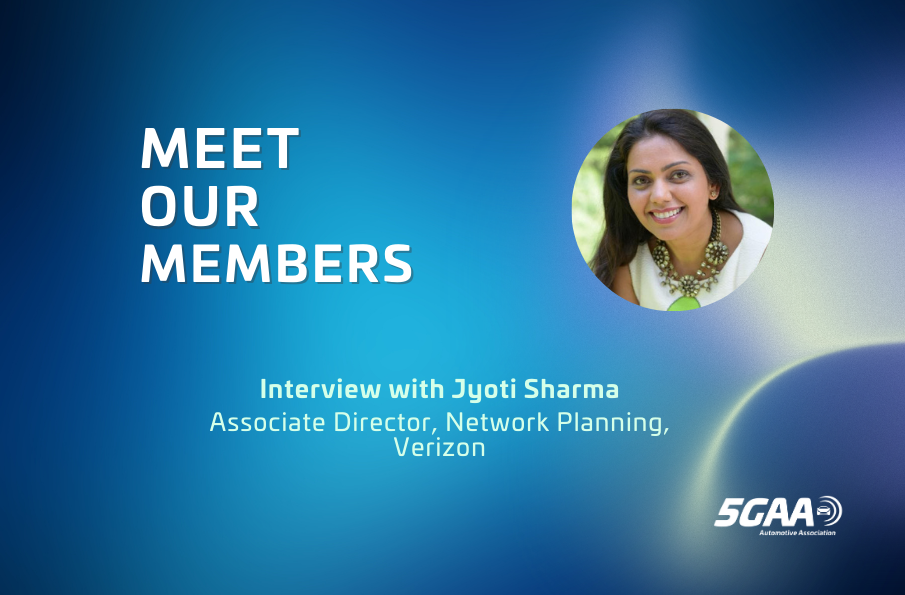Meet Our Members – Interview with Jyoti Sharma, Verizon

In our ongoing “Meet Our Members” series, we explore the unique journeys and expertise of the individuals who make the 5G Automotive Association. Each interview sheds light onto the incredible work, vision, and passion of the people behind our organisation. You can check out our last conversation with Menno Malta, CEO of Monotch, here.
This time, we introduce Jyoti Sharma, Associate Director of Network Planning at Verizon and alternate board member at 5GAA since 2021. Jyoti has brought her deep industry insight to a range of work items, including Vehicle-to-Network-to-Everything (V2N2X) and has led initiatives such as the Vulnerable Road User (VRU) Demo. Her commitment to accelerating the large-scale deployment of V2X technologies make her a valuable contributor to the 5GAA, and we’re excited to learn more about her perspective on the future of 5G and MEC in transportation.
Could you tell us briefly about Verizon’s involvement in 5GAA and how your company benefits from being a member?
Verizon has been an active member of 5GAA since its inception. We started out as a general member and initially contributed at the working group level. We saw tremendous value in taking a leadership role in 5GAA as a major U.S. telecommunications provider and were elected by the members as a gold board member in 2021. Currently, Verizon is a platinum board member of 5GAA and we are playing a critical strategic role as one of the key stakeholders in the V2X ecosystem.
When did you first become part of the 5GAA board? What are some of your responsibilities, and what has been your most rewarding experience so far?
I represent Verizon on the 5GAA board as an alternate board member since 2021. In my role as a board member I have the privilege and responsibility to ensure 5GAA remains focused on key strategic focus areas which will accelerate a large-scale deployment of Vehicle-to-Everything (V2X) across the globe. My most rewarding experience has been to collaborate with other 5GAA members who are leaders from auto OEM customers, their tier 1 suppliers, chipset and module providers and other ecosystem partners. This technical collaboration between all the stakeholders is the key to drive innovation and unlock the full potential of V2X communications at scale and make it a reality.
Can you share any recent examples of how Verizon has collaborated with other 5GAA members to drive innovation in the industry?
Verizon has taken a leadership role in bringing the V2X ecosystem partners together under the 5GAA umbrella. We have demonstrated thought leadership in defining the network architecture to solve challenging V2X requirements leveraging key technology enablers such as 5G, multi-access edge computing (MEC) and Hyper Precise Location. Our recent V2X VRU (Vulnerable Road User) demo in Detroit showcasing interoperability between different network operators and application providers generated a very positive response and engagement from auto OEMs, Departments of Transportation and road operators. The demo was successful due to close collaboration with several 5GAA member companies.
As the lead of the VRU DEMO Work Item, could you elaborate on the significance of demonstrating interoperability in the context of Vulnerable Road User protection solutions?
VRU DEMO is one of the key strategic focus areas at the 5GAA board level that the industry has been trying to address for many decades. We believe the C-V2X and other technology enablers (5G, MEC, Hyper Precise Location) are ready to mitigate the number of road accidents involving vulnerable road users such as pedestrians and cyclists. In order to deploy such a VRU solution at scale it needs to work across multiple operators, multiple auto OEMs, multiple application providers and multiple cloud providers. We reached a significant milestone by demonstrating interoperability amongst different stakeholders and showcased the technology is ready to deploy at scale with existing networks. The learnings from the demo are being replicated in other parts of the world and are informing U.S. DOT V2X Deployment plans.
What criteria were used to select the specific use cases for demonstration in VRU DEMO? How did these use cases represent real-world scenarios and challenges?
There has been extensive discussion within 5GAA to define different VRU scenarios. Different flavors of VRU use cases have been documented in published technical reports. The demo team carefully selected most common real world VRU scenarios such as active pedestrian crossing alert and using roadside cameras and artificial intelligence, machine learning logic in the MEC to detect pedestrians and alert the drivers to avoid potential collision.
Verizon participated in the demos with a showcase of its network solution using multi-access edge computing. How does MEC differ from traditional network-based computing in terms of its benefits for VRU protection applications?
MEC allows us to bring traditional cloud compute and storage within the mobile network closer to the edge where the data is generated reducing the end to end latency. It is well established that MEC is a key differentiator and technology enabler for latency critical use cases such as VRU protection. Verizon has already deployed public MEC across the United States in partnership with cloud providers. We continue to drive innovation by developing standard MEC and Network APIs for application providers. During the VRU demo we demonstrated near real time VRU alerts over 5G and applications hosted on Verizon’s Detroit MEC.



